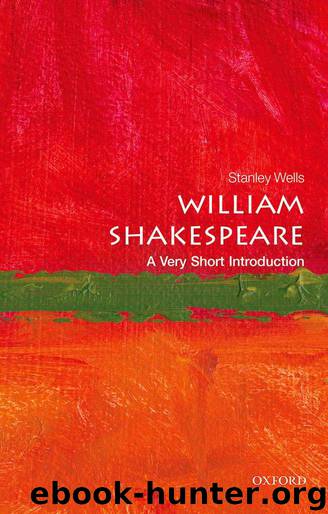William Shakespeare: A Very Short Introduction (Very Short Introductions) by Stanley Wells

Author:Stanley Wells [Wells, Stanley]
Language: eng
Format: epub
ISBN: 9780198718628
Publisher: Oxford University Press
Published: 2015-02-27T00:00:00+00:00
Richard II, Henry IV, and Henry V
After his sequence of history plays about Henry VI and Richard III, often referred to as the first tetralogy, Shakespeare mined English history again to reshape events of the past into dramatic form in another sequence of four interrelated plays that display a far broader spectrum of dramatic styles.
Richard II tells the beginning of the story whose end had been staged in Richard III: Bolingbroke’s usurpation of the throne from Richard II had set in train the entire series of events that are finally expiated only in the union of the houses of York and Lancaster celebrated in the last speech of Richard III. Again the focus is firmly on a single character, but Richard II is far more introverted and morally ambiguous than Richard III.
Though this play’s narrative flows directly into the next in the sequence, Henry IV, Part One, both its dramatic mode and its linguistic style are so different from the later plays that it seems clear that Shakespeare did not conceive them as a sequence. Every character in Richard II—even the gardeners who compare the state of England under Richard to a neglected garden ‘swarming with caterpillars’ (3.4.48)—speaks entirely in patterned verse; Shakespeare forgoes stylistic variety in favour of an intense, plangent lyricism that is especially well suited to the introverted, self-pitying King. Initially he is unsympathetic, frivolous, and irresponsible: having banished Mowbray and Bolingbroke in the scene of the lists, he behaves callously to Bolingbroke’s father, John of Gaunt, whose warnings against his unkingly conduct in the eloquent ‘This royal throne of kings’ speech (2.1.31–68) he ignores, and after his death confiscates his property with no regard for Bolingbroke’s rights. During Richard’s Irish campaign Bolingbroke returns from exile and gains support in his efforts to claim his due rights.
As the balance of power shifts Richard becomes more sympathetic, eloquent in his laments. When he abdicates, the slow transference of power is brought about in a scene of lyrical expansiveness, and he becomes pitiable as he is led to prison while his Queen is banished to France. The self-exploration that helps to draw us to him climaxes in his poignant prison soliloquy shortly before he is murdered. Finally Bolingbroke, now King Henry IV, plans a penitential pilgrimage to the Holy Land.
Some three years later, Shakespeare turned the events of the reign of King Henry IV into what turned out to be two plays—Henry IV, Parts One and Two—followed by their natural sequel, Henry V.
At the opening of Henry IV, Part One Henry, haunted by guilt and anguished by both national and filial rebellion, laments the fact that state affairs have aborted his planned pilgrimage. We had heard in Richard II of his dissatisfaction with Hal; this play is to show how Hal gradually, and with setbacks, redeems himself in his father’s eyes. Shakespeare structures the play on the rivalry between Hal and Hotspur, the honour-hungry offspring of the King’s opponent the Earl of Northumberland, making them both roughly the same age even though, historically, Hal was twenty-three years younger.
Download
This site does not store any files on its server. We only index and link to content provided by other sites. Please contact the content providers to delete copyright contents if any and email us, we'll remove relevant links or contents immediately.
4 3 2 1: A Novel by Paul Auster(12286)
The handmaid's tale by Margaret Atwood(7679)
Giovanni's Room by James Baldwin(7192)
Asking the Right Questions: A Guide to Critical Thinking by M. Neil Browne & Stuart M. Keeley(5638)
Big Magic: Creative Living Beyond Fear by Elizabeth Gilbert(5614)
Ego Is the Enemy by Ryan Holiday(5294)
The Body: A Guide for Occupants by Bill Bryson(4974)
On Writing A Memoir of the Craft by Stephen King(4863)
Ken Follett - World without end by Ken Follett(4645)
Adulting by Kelly Williams Brown(4487)
Bluets by Maggie Nelson(4474)
Eat That Frog! by Brian Tracy(4435)
Guilty Pleasures by Laurell K Hamilton(4360)
The Poetry of Pablo Neruda by Pablo Neruda(4040)
Alive: The Story of the Andes Survivors by Piers Paul Read(3969)
White Noise - A Novel by Don DeLillo(3954)
Fingerprints of the Gods by Graham Hancock(3942)
The Book of Joy by Dalai Lama(3901)
The Bookshop by Penelope Fitzgerald(3777)
